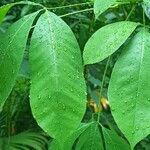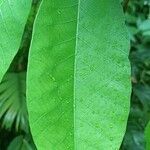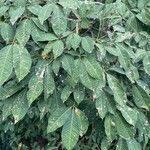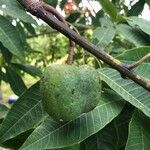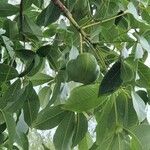Tree to 20 m high. Stipules lanceolate, 1–2 mm long. Leaves: petiole 6–30 cm long; leaflets elliptic, elliptic-lanceolate, obovate or oblanceolate, 5.5–25 cm long, 2.5–10 cm wide; base attenuate to cuneate; tip acuminate; lateral veins 15–25 per side of midribs. Male flowers: calyx lobes lanceolate, 2–3.2 mm long, 0.5–0.8 mm wide, tube 1–1.8 mm long; staminal column 1.5 mm long, anthers 10. Female flowers: calyx lobes lanceolate, 2.4–4 mm long, 0.8–1.5 mm wide, tube 1.8–2 mm long. Fruit globose, c. 40 mm long, 45 mm diam. Seeds ovoid, c. 23 mm long, 15 mm wide. [Description of fertile structures has been made from non-Australian material.]
Petioles 6–20(30) cm long, glabrous; petiolules 1–1.5 cm long; petiole gland reniform; leaflets 7–20(25) × 3–8(10) cm, the median leaflet larger than the others, obovate to elliptic, acuminate at the apex, attenuate or cuneate at the base, chartaceous, glabrous above and beneath, somewhat glaucous beneath; midrib impressed above, prominent beneath; lateral nerves in 15–25 pairs, looped just within the margin.
A deciduous tree. It grows 20 m tall. The bark is smooth and grey. The leaves have 3 leaflets. They are dark green and 30-60 cm long. They are arranged in spirals. The flowers are pale yellow and occur in large panicles. They have a scent. The fruit is a capsule. It is large and has 3 lobes. They are held in clusters. The explode on opening. The seeds are speckled and 2.5 cm long.
Male flowers: buds ovoid, acuminate; calyx lobes 2 × 0.5 mm, narrowly lanceolate, somewhat contorted, acuminate, subacute, tomentellous; tube 1 mm long; disk ± annular; staminal column 1.5 mm high, anthers 10, in 2 whorls of 5; pistillode narrowly conical, puberulous.
Female flowers: buds as in the male; calyx lobes larger than in the male, otherwise similar; tube 2 mm long; disk scarcely visible; ovary 2 × 2 mm, subglobose, minutely papillose; stigmas 0.3 mm long, ± sessile, grooved.
Inflorescences up to 20 cm long, subterminal below the apical tuft of leaves; axis sparingly pubescent; bracts 0.5 mm long, deltate, fugacious.
Seeds 2.3 × 1.5 cm, ovoid-cylindric, pale grey, mottled and streaked with darker grey.
Fruits c. 4 × 4.5 cm, shallowly trigonous, glabrescent.
Stipules 1 mm long, lanceolate.
Tree up to 20 m tall.
Branches ± erect.
Twigs glabrous.
Bark pale grey.
